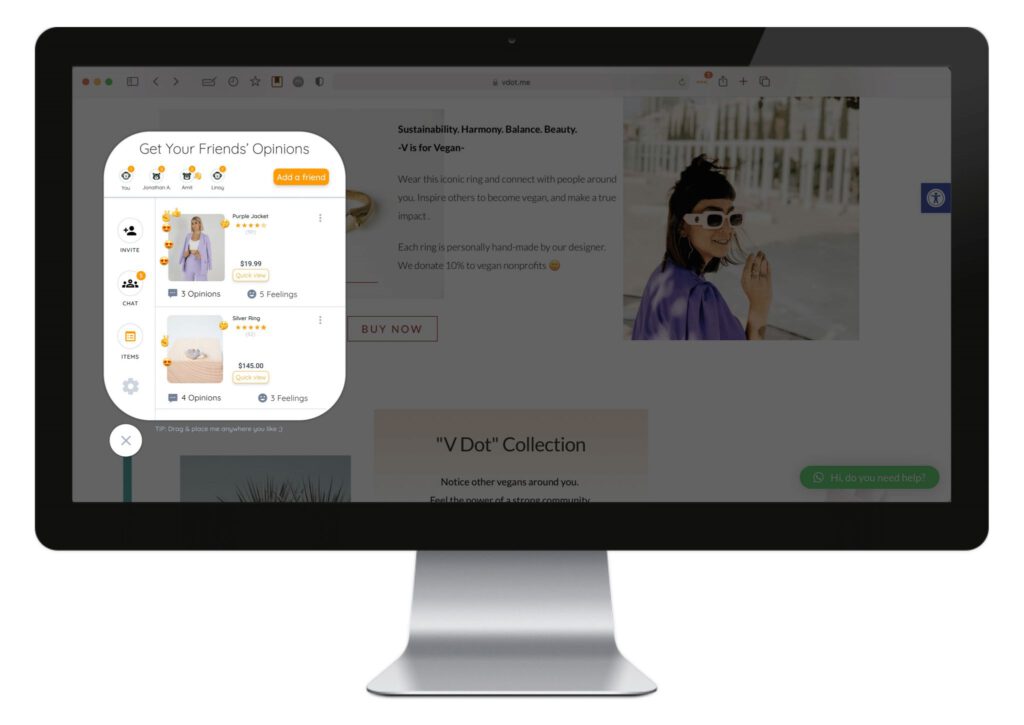Social commerce is a term with a few potential meanings. Some of the common perceptions involve brands creating shoppable content on their social media channels, working with influencers, or even just placing ads on social media platforms. When you think about how this type of sale happens — a consumer clicks a link that happens to be on a social media site — it makes you wonder what exactly makes this “social” shopping. Since when does clicking a link count as something “social?” However, there is a better way to understand social commerce in 2021.
With the advent of social shopping technology, the most important understanding of social commerce comes from the terms themselves: “Social” — based on real interactions between people — and “commerce” — the selling of goods. In that sense, social commerce in 2021 can be understood as the use of technology to enable real-time social interactions to enhance the digital customer experience.
The Big Disconnect: Social Commerce is Just Social Media Marketing & Selling
One commonly accepted definition of social commerce, as used by eMarketer, is “products or services ordered via social networks, such as Facebook, Instagram, Pinterest, TikTok, WeChat, Line, VK, and others, either by buying directly on the social platform, such as via Instagram Checkout or WeChat Mini Programs or through clicking links on the social network that lead to the retailer’s product page to complete the purchase.”
However, although this sale takes place on a social media site, it is still a one-way transaction, rather than something that’s being shared or discussed in the moment by potential customers and their friends and family, which is what most of us would consider a “social” activity. (you can read more about this in our last blog)
If consumers want to discuss the potential purchase or seek opinions before clicking “buy,” they have to take an extra step — copying and pasting links to items into a different platform, whether it’s a text message or a messaging app like WhatsApp. They then ask their friends to weigh in, and that’s where the purchase cycle often bogs down. Maybe the links expire or the friends don’t reply right away. At that point, they may become frustrated and decide to start over later or just abandon the purchase.
Enabling True Social Commerce with a Social Shopping Platform
While social media is — and will continue to be — a key channel for customer acquisition via ads, it would be a misunderstanding to think that it goes beyond that stage of the customer journey.
“Social media has become just ‘media,’ as in, just another place where people are getting eyeballs on ads. It’s not actually an interactive experience; even soliciting comments and ‘likes,’ doesn’t provide the social validation that’s important during shopping. That can only happen either in person or when you’re using a tool that allows people to interact the way they would in person — and the latter has become increasingly important.”
Gloria Stitt, VP of Marketing at Joyned
Enter Joyned, the only collaborative ecommerce platform that provides a cross-website, live shopping experience to online consumers. Users can invite their friends to discuss, deliberate, critique, and hopefully buy an item or book travel … together.
With Joyned, you can put the “social” back in social commerce. Say you want your friends’ input on a dress to wear to an upcoming wedding. You can put together a list of options and invite friends to join you — live — on the website where everyone can offer assessments and comments as a group. The friends can even do their own browsing and offer other choices of styles or colors they prefer. The key for brands is that the entire experience happens on their own website, allowing them to own the experience, organically acquire new customers, improve conversion and capture the valuable data that would otherwise belong to messaging apps or media middlemen.
The Benefits of True “Social Commerce”
There are numerous reasons brands should prefer that shopping shift off the social platform and onto their website.
First, it encourages people to linger on your site and discuss products with their friends. As this robust engagement happens onsite, brands gain insight into consumer attitudes about their products and services since the brand itself — not social media platforms or media companies — is able to capture the conversation. “Otherwise those platforms are owning the experiences, harvesting behavioral data and providing those insights to your competitors who are potentially using it to retarget your customers who have already shown their interest in your products,” Stitt notes.

A social shopping platform like Joyned overlays directly onto your digital storefront and allows social interactions to happen right on your site — where you own the experience.
Shopping together via Joyned also decreases cart abandonment. In a typical scenario, a consumer might add a product to the cart only to become distracted while they wait for their friends to weigh in. At that point, the brand has to work to regain that attention by sending them a reminder — and more often than not, piling on a discount to sweeten the deal. But with Joyned shoppers can get reactions from those influential friends immediately, increasing the likelihood of a purchase. When brands own the entire purchase journey, shoppers are more likely to convert profitably.
But most brands are likely to agree that the top benefit of Joyned is the organic traffic it generates, as the original customer invites others. Most importantly, it’s not random traffic, created through statistical guesswork chosen by an AI and based on demographics or age brackets. Instead, these are people who have a concrete reason to be on the site, and it pays off: Joyned has found these invitees have a longer lifetime value and spend 40% more than the average website visitor. Joyned is able to prove these numbers, based on A/B tests it runs directly on the merchant’s site. They’ll expose half of the customers to the platform and then compare conversion rates, average order value, and sales between the two groups.
“Even more beneficial is the fact that this is traffic you didn’t have to pay Facebook or another paid platform for in the first place,” notes Jonathan Abraham, CEO and Co-Founder of Joyned “It’s a double bonus of boosting conversion through qualified traffic and then increasing profitability, due to higher average order value and lower acquisition costs.”
As consumers flock to eCommerce, they are hungry for a true social commerce tool that streamlines the process of shopping with friends, and [Joyned] fits the bill, with 75% of the users that clicked to use Joyned reporting it was a helpful tool in one pilot experiment.
Brands are realizing there is a better way to create a true social shopping experience, with Joyned leading the way.
Sites that use Joyned saw powerful increases:
Retention Rate: +249%
Conversion Rate: 398%
Organic Traffic: +38% per user
Retention Rate: +249%





